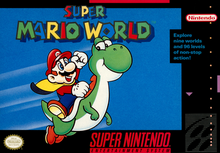
Back سوبر ماريو ورلد Arabic سوبر ماريو ورلد ARZ Super Mario World AST Super Mario World Byelorussian Super Mario World Catalan سووپەر ماریۆ وۆرد CKB Super Mario World Welsh Super Mario World Danish Super Mario World German Super Mario World Greek
| Super Mario World | |
|---|---|
 North American box art | |
| Developer(s) | Nintendo EAD |
| Publisher(s) | Nintendo |
| Director(s) | Takashi Tezuka |
| Producer(s) | Shigeru Miyamoto |
| Designer(s) | |
| Programmer(s) | Toshihiko Nakago |
| Artist(s) | Shigefumi Hino |
| Composer(s) | Koji Kondo |
| Series | Super Mario |
| Platform(s) | Super Famicom/Super NES, Game Boy Advance |
| Release | SNESGame Boy Advance |
| Genre(s) | Platform |
| Mode(s) | Single-player, multiplayer |
Super Mario World, known in Japan as Super Mario World: Super Mario Bros. 4,[a] is a 1990 platform game developed by Nintendo EAD and published by Nintendo for the Super Nintendo Entertainment System (SNES). The player controls Mario on his quest to save Princess Peach and Dinosaur Land from the series' antagonist Bowser and the Koopalings. The gameplay is similar to that of earlier Super Mario games; players control Mario through a series of levels in which the goal is to reach the goalpost at the end. Super Mario World introduces Yoshi, a ridable dinosaur who can eat enemies.
Nintendo Entertainment Analysis & Development developed the game, led by director Takashi Tezuka and producer and series creator Shigeru Miyamoto. It is the first Mario game for the SNES and was designed to make the most of the console's technical features. The development team had more freedom compared to the series installments for the Nintendo Entertainment System (NES). Yoshi was conceptualised during the development of the NES games but was not used until Super Mario World due to hardware limitations.
Super Mario World is often considered one of the best games in the series and is cited as one of the greatest video games ever made. It sold more than twenty million copies worldwide, making it the best-selling SNES game. It also led to an animated television series of the same name and a 1995 sequel, Yoshi's Island. The game has been re-released on multiple occasions: It was part of the 1994 compilation Super Mario All-Stars + Super Mario World for the SNES and was re-released for the Game Boy Advance as Super Mario World: Super Mario Advance 2 in 2001, on the Virtual Console for the Wii, Wii U, and New Nintendo 3DS consoles, and as part of the Super NES Classic Edition. In 2019, it was released for Nintendo Switch Online as part of the classic games service.
- ^ "Nintendo's Super NES arrives". The Press Democrat. Santa Rosa, California: 36. 22 August 1991. Archived from the original on 19 April 2021. Retrieved 19 April 2021.
- ^ Cite error: The named reference
GRwas invoked but never defined (see the help page). - ^ Cite error: The named reference
NLifewas invoked but never defined (see the help page). - ^ Phillips, Tom (29 November 2012). "How does the Wii U launch line-up compare to the SNES, N64 and GameCube's?". Eurogamer. Eurogamer Network. Archived from the original on 1 December 2017. Retrieved 18 November 2017.
- ^ "GameSpot: Game Boy Advance News: Super Mario Advance 2 ships". 27 March 2002. Archived from the original on 27 March 2002. Retrieved 19 April 2023.
- ^ "Super Mario Advance 2: Super Mario World". Nintendo Life. Archived from the original on 25 June 2019. Retrieved 2 December 2020.
- ^ "Mario Advance 2 set for April release". Eurogamer.net. 6 February 2002. Archived from the original on 20 September 2023. Retrieved 19 April 2023.
Cite error: There are <ref group=lower-alpha> tags or {{efn}} templates on this page, but the references will not show without a {{reflist|group=lower-alpha}} template or {{notelist}} template (see the help page).